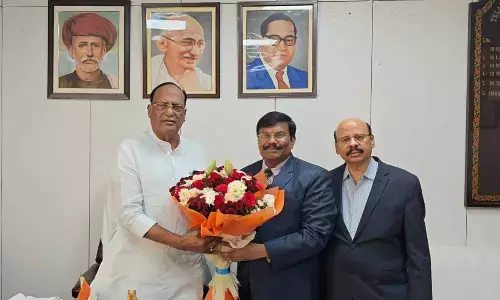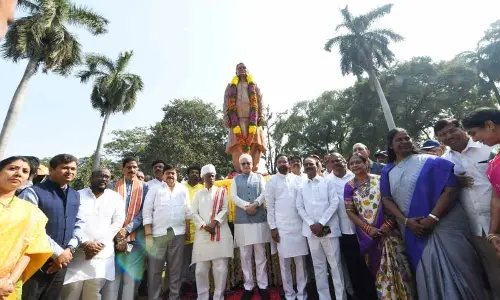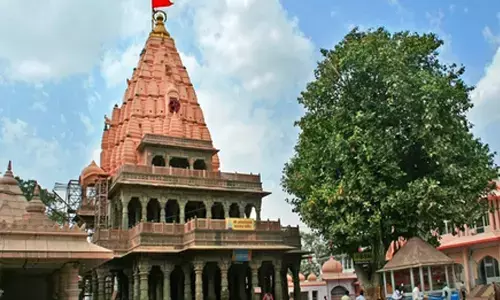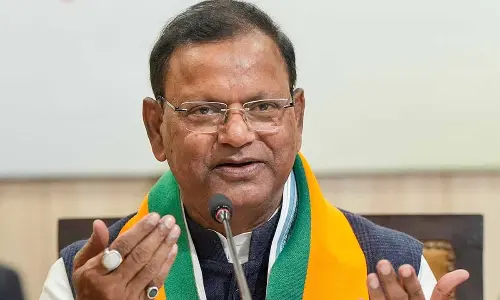Two CMs, One Scheme!
Two CMs, One Scheme, Rice At Two Rupees. When NT Rama Rao promised rice at two rupees a kilogram in 1982, it was greeted with derision by the Congress party. Their assessment was that it could never be done and that the public itself would not believe this promise, and reject it as lacking credibility.
NT Rama Rao’s promise of rice at Rs 2 per kg in 1982 was initially met with derision by the Congress party, which later adapted it as poll strategy albeit without proper homework. When NTR came to power, he too was misled into thinking that the scheme was a cakewalk without any burden of subsidy on the state government
.jpg) When NT Rama Rao promised rice at two rupees a kilogram in 1982, it was greeted with derision by the Congress party. Their assessment was that it could never be done and that the public itself would not believe this promise, and reject it as lacking credibility. However, as weeks passed by, the Congress sensed that the public had been greatly enthused by the promise as also his promise to fight corruption. Rama Rao was receiving increasing support, including for the reason that Telugu pride had been hurt by the Rajiv Gandhi-Anjaiah incident.There was now rethinking in the Congress party about the two rupees rice scheme. At this juncture, Vijayabhaskara Reddy assumed power as the third Congress Chief Minister (CM) of the year 1982.
When NT Rama Rao promised rice at two rupees a kilogram in 1982, it was greeted with derision by the Congress party. Their assessment was that it could never be done and that the public itself would not believe this promise, and reject it as lacking credibility. However, as weeks passed by, the Congress sensed that the public had been greatly enthused by the promise as also his promise to fight corruption. Rama Rao was receiving increasing support, including for the reason that Telugu pride had been hurt by the Rajiv Gandhi-Anjaiah incident.There was now rethinking in the Congress party about the two rupees rice scheme. At this juncture, Vijayabhaskara Reddy assumed power as the third Congress Chief Minister (CM) of the year 1982.
The new CM called a stock-taking meeting of all the senior officers as was customary. At the time, I was the Commissioner of Rural Development, a post created for the first time in Andhra Pradesh (AP). After the meeting was over the CM stood at the exit to shake hands with and see off the officers. When my turn came he asked me to stay back saying he wanted to discuss something. After everyone left he sought my opinion on whether the two rupees rice scheme was feasible of implementation, especially given the quantities that would need to be procured from the rice millers.
The reason he was verifying this with me was the senior most officers had gone on record advising him that it was not feasible. I told the CM that it was eminently feasible but it would need a subsidy about which, perhaps, NT Rama Rao was not aware but which had to be recognised. As for administrative feasibility, that it could be done was beyond doubt. I told the CM that we could always be certain that in AP a programme based on rice would be ever a sure success for we had enough of it and that was our real strength. The CM asked me whether I would undertake the responsibility of implementing the programme. I agreed but pointed out to him that till then we had in AP an informal public distribution system (PDS), which was essentially urban, biased in favour of Hyderabad and Visakhapatnam and a few other towns; there was hardly any PDS worth the name in rural areas but NTR’s promise was rice for everyone in the entire state and therefore answering his challenge would mean an altogether new, expanded PDS covering all of AP including its rural areas in terms of price and a certain guaranteed quantity of entitlement; that would mean fixing household eligibility norms, identification of all such eligible households and their being issued formal entitlement cards, unlike the “ration” card then in existence where there was no promise of regular, guaranteed supply.
For this we would need to step up our annual raw rice procurement from an average 5-6 lakh tonnes to treble that quantity, which would need many new administrative measures including negotiations with the Central Government for revising drastically upward the central pool allotment to AP. Norms for eligible households would involve intense training of enumeration personnel and sending them to the field for identification and subsequent distribution of the household cards. All these preparations would need 6 months of lead time. As against this, the General Elections were due in a month’s time! I told the CM that while I would take up this responsibility, nothing credible could be done at this late hour as in such a programme time and meticulous preparations were the essence.
The CM said that all this could be done on the Congress returning to power but for now the idea was to counter NTR’s promise on the price front. He would speak to the Prime Minister for larger allocation of rice to AP in the coming days preceding the Elections so that larger quotas could reach the people.
In those days rice was classified by the Government of India into three varieties and notified as Common, Fine and Super Fine. Their reigning market prices in AP in 1982 were about Rs. 2.50 for the common and Rs. 2.80 for the fine and super fine varieties. Now, NTR was promising to sell all varieties of rice at Rs 2 per kg regardless of variety.

I assumed charge as Commissioner of Civil Supplies (CCS) on the November 12, 1982. However, without consulting me, an announcement was made that Common, Fine and Super Fine varieties respectively would be sold in the fair price shops at Rs. 1.90, Rs. 2.10 and Rs. 2.15.This was supposedly a “political master stroke” against NTR’s price of two rupees because, after all, Congress can give you rice at Rs. 1.90, better than NTR’s price of 2 rupees! On whose foolish advice this announcement was made, whether by some over-clever bureaucrats or spin master politicians, I never came to know but I told the CM without wasting any time that this was going to be disastrous for his party.
The reason was that most of the rice being produced in India was either fine or superfine and hardly 10 percent of the rice produced or procured was common rice. And here the Government was promising rice that is not even adequately grown, and therefore not procured sufficiently, to the poor at a lower price of Rs 1.90 per kg just days before the election when it had no capacity to deliver it! How would the people react when they went to the FP shop demanding the Rs 1.90 variety rice, if the dealer told them that the Government had just not supplied to them that 1.90 rupee variety they wanted? The second whammy was that while a brownie point would be won against NTR, no FP shop dealer was going to return 10 paise after delivering the rice to the poor card holder when she tendered two rupees.
The helpless cardholder was unlikely to forget this injustice when she reached the polling station a few weeks hence. The third whammy was the Congress was selling the only available fine and super fine varieties at 10 and 15 paise above the 2 rupees promised by Rama Rao. All this was unknown to the Congress strategists who I suspect included some civil servants. Anyone who cares to read the UPA II’s National Food Security Act 2013 would notice that this “strategy” has been repeated there by promising coarse grains like Jowar, Bajra, Maize and Ragi at 1 rupee a kg, the truth being their current levels of production or procurement can never support the promised right to these grains. To obfuscate this, the Act defines “food grains” to mean a “combination of all grains”!Then why talk of nutritious grains at one rupee?
Predictably the Congress was routed in the 1982 elections bringing NT Rama Rao,a non-Congress leader and his Telugu Desam Party (TDP) for the first time ever to power in AP.
I continued as CCS with NT Rama Rao as well. While civil servants of those days held varying opinions about him, I had the highest respect and regard for him, especially because he wanted the poor to be free from hunger. At a personal level he was impeccably courteous towards me. I had complete freedom of speech with him as with any other leader, though some officers did feel constrained by his style.
Rama Rao’s desire was to provide rice to the entire population of AP at Rs 2 per kilogram; and he had been convinced that there would be no need for government to incur any subsidy to distribute rice to all at that price. He had come to believe that it was entirely owing to corruption in governance that rice was being sold at a price higher than two rupees. He had not been advised by his “party economists”, of whom I heard frequently from him, about the economics of food distribution such as the statutory Minimum Support Price (MSP) for paddy from which rice was derived; or the FCI’s Consumer Issue Price; or the transportation and FP shop commission costs in a system where the consumer’s end price was Rs.2.
That was very surprising considering that very senior leaders were part of theTDP. On the very first day of my meeting the CM, he told me that no subsidies would be provided for the rice scheme. I told him promptly - if so his scheme would not take off. When in reply the CM quoted a “party economist” about his stand, I sought a discussion with his “party economist” in his presence. The “economist” was promptly summoned and in the next few minutes I showed the subsidy requirements needed to provide rice at two rupees per kilogram. Finance Secretary Madhava Rao was also present at this encounter.
That subsidy, I explained, was in addition to the subsidy that the Centre bore for the rice the State was provided from the central pool through the FCI. While the more AP distributed the more subsidy it gained from the Central Government, it correspondingly spent more on subsidy from the State’s coffers for selling the rice at Rs. 2. With all these facts set out the “party economist” drawn from a very important Hyderabad think tank withdrew from the discussion.





















